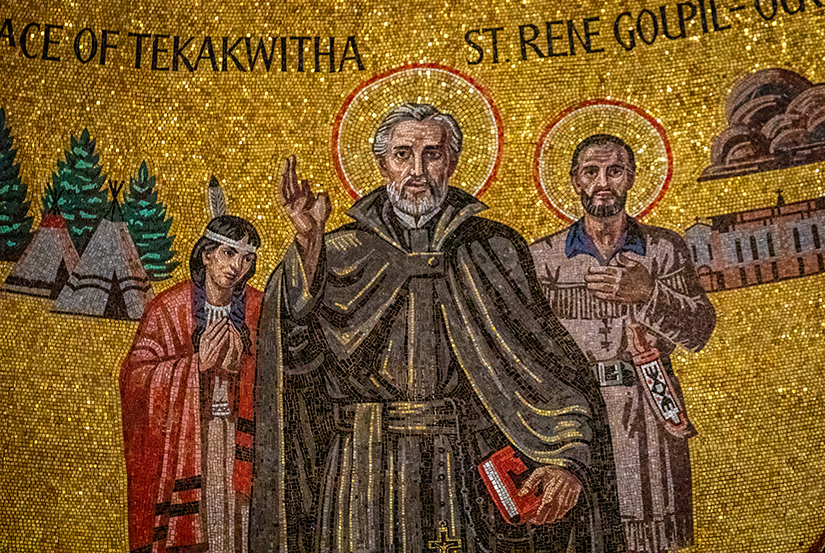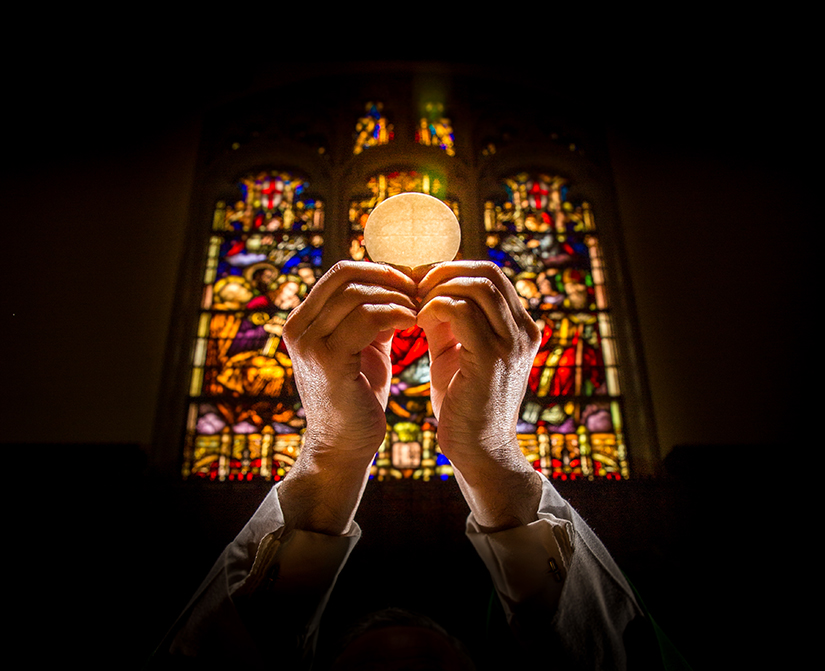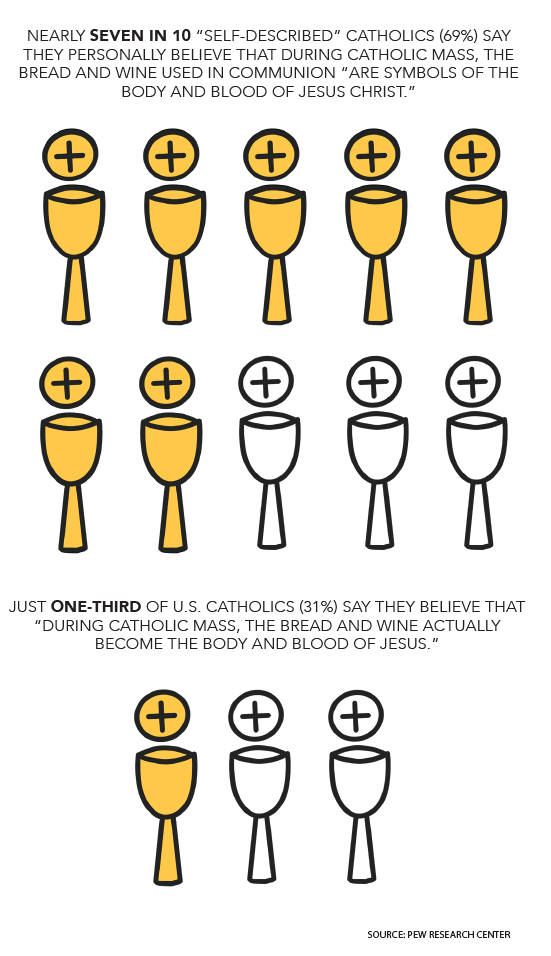Popular images of St. Isaac Jogues depict the 17th century saint without a thumb, or sometimes missing one or both index fingers. The French-born Jesuit missionary who had traveled to Canada to evangelize, was captured by Native Americans, his hands mutilated.
The injuries left it impossible for him to celebrate the Mass. At the time, Church law required the use of a forefinger and thumb in the consecration of the Eucharist. His suffering and eventual martyrdom is just one example of many saints and early Christians who were, for various reasons, deprived of the Eucharist.
 Mosaic of St. Isaac Jogues inside the Cathedral Basilica of Saint Louis in St. Louis.Photo Credits: Lisa JohnstonWith the cancellation of public Masses around the world because of the coronavirus pandemic, Catholics here are experiencing what it is like to go without receiving Communion for an extended period of time. Learning about the stories of other moments in Church history in which the Eucharist was not available, and putting that into the context of our modern-day circumstances, is an opportunity for Catholics to gain a deeper appreciation for the Eucharist, said Father Nicholas Smith, director of the archdiocesan Office of Worship.
Mosaic of St. Isaac Jogues inside the Cathedral Basilica of Saint Louis in St. Louis.Photo Credits: Lisa JohnstonWith the cancellation of public Masses around the world because of the coronavirus pandemic, Catholics here are experiencing what it is like to go without receiving Communion for an extended period of time. Learning about the stories of other moments in Church history in which the Eucharist was not available, and putting that into the context of our modern-day circumstances, is an opportunity for Catholics to gain a deeper appreciation for the Eucharist, said Father Nicholas Smith, director of the archdiocesan Office of Worship.
While most people aren’t able to attend Mass right now, he stressed the importance of making an act of spiritual Communion, as another way of staying connected to Jesus in the Eucharist.
“My hope is that there’s an increased understanding of the Eucharist that comes of this,” Father Smith said. “While most people can’t attend Mass, we need to understand that in every Mass the priest continues to celebrate, they’re praying for the Church. They are still praying for their parish and the whole Church, even if the people aren’t present.”
Examples in Church history
There are many examples in Church history — from the days of the first Christians to recent times of war — in which Catholics have gone without receiving the Eucharist because of unusual circumstances, said Msgr. Michael Witt, professor of Church history at Kenrick-Glennon Seminary and the author of several books on Church history in the Archdiocese of St. Louis.
In 16th century Japan, missionaries converted as many as 300,000 Catholics. But by the end of the century, the Japanese government increasingly saw Catholicism as a threat and began persecuting Catholics. Christianity was banned, and those Japanese who refused to abandon their faith were killed. A group of 26 Japanese Catholics — known as the Holy Martyrs of Japan — were executed by crucifixion on Feb. 5, 1597, at Nagasaki. It wasn’t until Christian missionaries returned to Japan 250 years later (St. Maximilian Kolbe among them) that a community of “hidden Catholics” practicing their faith underground was discovered.
St. Isaac Jogues, who lived in the 17th century, was deprived of the Eucharist even as a priest, the mutilation of his hand suffered as a captive of the Mohawk Nation. His finger and thumb were severed during his captivity. At the time, no priest was allowed to celebrate Mass if he did not have his thumb and index finger to hold together after consecrating the Eucharist. It wasn’t until he returned to France more than a year later that he was given a special dispensation to celebrate Mass once again. He eventually returned to North America and was martyred there in 1646. Msgr. Witt, writing in the series, “Saint Louis: The Story of Catholic Evangelization of America’s Heartland,” addressed the deprivation that Catholics faced during World War II. He cited a group of Marines on the island of Guam who had not been able to attend Mass for weeks. One day, they encountered what they thought was a Japanese officer. “The guy shouted ‘Don’t shoot, I’m a Catholic priest,’” Msgr. Witt said. “The guys brought him back to their unit and celebrated Mass.” Another story included Father Walter Boul, a priest of the Archdiocese of St. Louis, who had written a memoir of his experiences serving in World War II. “He talks about being in a barn by himself in Luxembourg,” Msgr. Witt said. “With 88 millimeter shells exploding all around him, he’s celebrating Mass on the hood of his Jeep.”
There’s also the 1918 influenza (Spanish flu) pandemic. According to the CDC, it was estimated that about 500 million people or one-third of the world’s population became infected with the virus. The number of deaths was estimated to be at least 50 million  Photo Credits: Lisa Johnstonworldwide with about 675,000 occurring in the United States.
Photo Credits: Lisa Johnstonworldwide with about 675,000 occurring in the United States.
At the time, Cardinal John J. Glennon suspended public Masses. “Cardinal Glennon was not happy about it, but he went along with” recommendations of local health officials, Msgr. Witt said. “For a significant period of time, there were no Masses in the archdiocese.” Understanding Canon Law
The Church’s Code of Canon Law addresses the reception of the Eucharist. One of the most well-known passages is the obligation to receive Communion at least once a year. “After being initiated into the Most Holy Eucharist, each of the faithful is obliged to receive holy communion at least once a year” (Canon 920). But what does this mean exactly?
When the law was promulgated, it was a sort of stop-gap measure to hold back lamentable practices where Christians would go for long periods without receiving Communion for a variety of reasons, said Father Aaron Nord, a canon lawyer and adjudant judicial vicar with the archdiocesan Metropolitan Tribunal. “This would have been cases (in which people) considered themselves Catholic but neglected Mass or went to Mass without receiving Holy Communion, though they were in a state of grace,” Father Nord said. “Some theological movements placed very high demands on those who would receive Holy Communion, leading people to rarely receive Communion.”
The law also states: “This precept must be fulfilled during the Easter season unless it is fulfilled for a just cause at another time during the year.” The phrase “just cause” includes any good reason, such as a pandemic in which public Masses are cancelled.
Another law, Canon 912, states that “any baptized person not prohibited by law can and must be admitted to Holy Communion.” Ordinarily, “if you want to receive the sacrament and are well-disposed, you should be allowed,” Father Nord said.
But while there is a right to receive Holy Communion, ecclesiastical authority has the right to tell Catholics to respect the common good as they use their right, Father Nord stressed.
Canon 223 also states: “In exercising their rights, the Christian faithful … must take into account the common good of the Church, the rights of others, and their own duties toward others. In view of the common good, ecclesiastical authority can direct the exercise of rights which are proper to the Christian faithful” (Canon 223, paragraph 1-2).
Archbishop Carlson decided that Holy Communion should be restricted to the very ill during the current pandemic, Father Nord noted. “This makes sense as a reasonable restriction that is temporary and responding to a very serious situation,” he said. “His decision also in line with what’s being done extensively throughout the world.”
>> The Real Presence
The Church teaches that Jesus is truly present in the Eucharist when the gifts of bread and wine are consecrated and become the  Photo Credits: Illustration by Abigail WitteBody and Blood of Jesus. But a Pew Research Center survey from August 2019 shows that only 63 percent of Catholics who attend Mass weekly or more believe in the Real Presence.
Photo Credits: Illustration by Abigail WitteBody and Blood of Jesus. But a Pew Research Center survey from August 2019 shows that only 63 percent of Catholics who attend Mass weekly or more believe in the Real Presence.
Also, nearly seven in 10 “self-described” Catholics (69%) say they personally believe that during Catholic Mass, the bread and wine used in Communion “are symbols of the Body and Blood of Jesus Christ.” And just one-third of U.S. Catholics (31%) say they believe that “during Catholic Mass, the bread and wine actually become the Body and Blood of Jesus.”
Our understanding of the Real Presence of Jesus in the Eucharist traces back to the early Church. There are plenty of references in Scripture, including when Jesus told His disciples, “I am the living bread which came down from heaven … if anyone eats this bread, he will live forever … I say to you, unless you eat the flesh of the Son of man and drink His blood, you have no life in you; he who eats my flesh and drinks my blood abides in me, and I in him. …” (John 6:25-58).
Of course, we can also find references in all four Gospels about Jesus’ institution of the Eucharist at the Last Supper. (Matthew 26:17-30; Mark 14:12-26; Luke 22:7-39; John 13:1-17:6).
The Real Presence of Jesus in the Eucharist is indeed a mystery. It is difficult for humans to understand this mystery, but we do our best to understand through definitions given to us by the Church, such as transubstantiation — which means to change from one substance to another. When the priest consecrates the bread and wine, we believe there is a miraculous transformation into the Body and Blood of Jesus. In this case, the substance changes, but the accidents (secondary characteristics, or the changeable aspects of a thing) stay the same.
There are many eucharistic miracles that help reinforce our belief in the Real Presence in the Eucharist. In one example, a Communion host that had fallen to the ground at a church in Poland in 2014 was later found to have a red substance on it. Scientists tested the host, and discovered that it was a piece of heart muscle that belonged to a man of Mediterranean/Middle Eastern descent in his 30s. The muscle had shown signs of great trauma.
God gives us the Eucharist because He wants to be with each one of us. The more we practice our faith, including making Mass a priority, the more we will grow in our appreciation for the Real Presence in the Eucharist. Because Catholics are not able to attend Mass right now, they should seek to be as united as possible with the Church’s prayer of spiritual communion. St. Thomas Aquinas described an act of spiritual communion as “an ardent desire to receive Jesus in the most holy sacrament and lovingly embrace Him” at a time or in circumstances when we cannot receive Him in sacramental Communion.